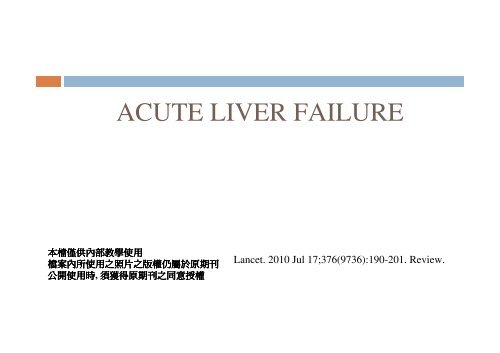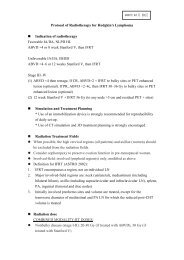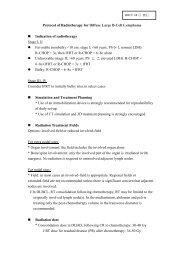ACUTE LIVER FAILURE
ACUTE LIVER FAILURE
ACUTE LIVER FAILURE
You also want an ePaper? Increase the reach of your titles
YUMPU automatically turns print PDFs into web optimized ePapers that Google loves.
<strong>ACUTE</strong> <strong>LIVER</strong> <strong>FAILURE</strong><br />
Supervisor: 陳 奇 祥 主 任<br />
Reporter: R1 黃 心 治<br />
本 檔 僅 供 內 部 教 學 使 用<br />
檔 案 內 所 使 用 之 照 片 之 版 權 仍 屬 於 原 期 刊<br />
公 開 使 用 時 , 須 獲 得 原 期 刊 之 同 意 授 權<br />
Lancet. 2010 Jul 17;376(9736):190-201. Review.
Introduction<br />
“acute liver failure” “fulminant hepatic failure” (1997-<br />
2009)<br />
Rare disorder, high mortality and resource cost<br />
mostly in young adults<br />
Rapidly progressive multiorgan failure and devastating<br />
complications<br />
Developing world: virus (esp. hepatitis E )<br />
USA and much of western Europe: drug-induced liver<br />
injury (paracetamol)<br />
A large proportion of cases are of unknown origin
Introduction<br />
Outcomes have been improved by use of<br />
emergency liver transplantation<br />
Emerging for supportive care/ better understanding<br />
of the pathophysiology of the disorder, especially<br />
in relation to hepatic encephalopathy
Clinical features of acute liver failure<br />
<br />
<br />
<br />
<br />
<br />
Whole body: Systemic inflammatory response/ High energy<br />
expenditure and catabolism<br />
Liver: Loss of metabolic function/ Decreased<br />
gluconeogenesis leading to hypoglycaemia/ Decreased<br />
lactate clearance leading to lactic acidosis/ Decreased<br />
ammonia clearance leading to hyperammonaemia/<br />
Decreased synthetic capacity leading to coagulopathy<br />
Lungs: Acute lung injury/ Adult respiratory distress<br />
syndrome<br />
Adrenal gland: Inadequate glucocorticoid production<br />
contributing to hypotension<br />
Bone marrow: Frequent suppression, especially in viral and<br />
seronegative disease
Clinical features of acute liver failure<br />
Circulating leucocytes: Impaired function and<br />
immunoparesis contributing to high risk of sepsis<br />
Brain: Hepatic encephalopathy/ Cerebral oedema/<br />
Intracranial hypertension<br />
Heart: High output state/ Frequent subclinical<br />
myocardial injury<br />
Pancreatitis: Particularly in paracetamol-related acute<br />
liver failure<br />
Kidney: Frequent dysfunction or failure<br />
Portal hypertension: Might be prominent in subacute<br />
disease and confused with chronic liver disease
O’Grady and colleagues<br />
O’Grady JG, Schalm SW, Williams R. Acute liver failure: redefining<br />
the syndromes. Lancet 1993; 342: 273–75.
Causes
Causes: Viral infections<br />
Hepatitis A<br />
Faecal–oral<br />
Poor hygiene and sanitation<br />
Control by eective use of hepatitis A vaccination in<br />
developed country<br />
Fewer than 3% of cases (acute liver failure) in a recent US<br />
study<br />
1.5 million clinical cases (worldwide every year)/ < 1% of<br />
patients will develop liver failure<br />
more severe in adults: esp. underlying chronic liver disease,<br />
especially that resulting from hepatitis C virus (benefit from<br />
targeted vaccination)
Causes: Viral infections<br />
Incidence of acute hepatitis per 100 000 people<br />
per year in USA, 1982–2007
Causes: Viral infections<br />
<br />
Hepatitis E<br />
Faecal–oral (contaminated water supply; sourse: unknow but evidence<br />
suggests a porcine origin)<br />
Endemic throughout tropical and subtropical countries<br />
Most common cause of acute liver failure in India and Pakistan, China,<br />
and southeast Asia<br />
Mortality probably
Causes: Viral infections<br />
Hepatitis E<br />
Although overall outcomes for liver failure related to<br />
hepatitis E can be good, mortality can exceed 50%<br />
when emergency liver transplantation is unavailable<br />
Transition from acute to chronic infection with<br />
persistent hepatic inflammation and viraemia can occur<br />
in immunosuppressed patients
Causes: Viral infections<br />
Hepatitis B<br />
Nearly 30% of acute liver failure in parts of Europe,<br />
and is a main cause in Asia, sub-Saharan Africa, and<br />
the Amazon basin<br />
感 染 者 中
Causes: Viral infections<br />
Hepatitis B<br />
Incidence of acute hepatitis per 100 000 people<br />
per year in USA, 1982–2007
Causes: Viral infections<br />
<br />
Hepatitis B<br />
<br />
<br />
<br />
<br />
<br />
<br />
Acute/ chronic infection when viral status changes<br />
seroconversion with transition from a phase of stable viral replication or<br />
inactive carriage to viral clearance/ superinfection with hepatitis D virus/ after a<br />
replication surge or reactivation.<br />
Spontaneously/ more commonly happens during or after treatment-induced<br />
immunosuppression for solid-organ or haematological malignant disease.<br />
Virus reactivation is associated with a much higher risk of progression to liver<br />
failure and death than is novel acute infection/ antiviral prophylaxis reduces<br />
mortality.<br />
Acute liver failure has a longer incubation and prodrome when associated with<br />
hepatitis B virus than with hepatitis A or E viruses, and typically has an acute<br />
rather than hyperacute presentation.<br />
Increased age/ a worse prognosis in disease from all viral causes
Causes: Viral infections<br />
<br />
<br />
<br />
Uncommon<br />
herpes simplex virus types 1 and 2<br />
human herpes virus 6<br />
varicella zoster virus<br />
Epstein-Barr virus<br />
cytomegalovirus<br />
parvovirus B19<br />
Acute hepatitis C infection is very rarely implicated as a<br />
cause in Europe and the USA, although cases have been<br />
reported in Japan and India.<br />
Few data suggest a major pathogenic role for SEN, TT<br />
(transfusion transmitted), or hepatitis G viruses.
Causation cannot be established in many cases; such seronegative or indeterminate liver<br />
failure happens worldwide, and are associated with especially poor survival with medical<br />
therapy alone, and frequently need emergency transplantation.<br />
Often associated with a subacute presentation, seronegative disease is a diagnosis of<br />
exclusion and its pathogenesis is poorly understood.<br />
Clinical features and associated haematological abnormalities can suggest viral infection, but<br />
serological testing for established and putatative hepatotropic viruses can be negative.<br />
Some patients can progress to chronic hepatitis with recurrence after liver transplantation.<br />
<br />
<br />
Demographic profile, HLA genotype, presence of autoantibodies, and histological findings<br />
suggest an autoimmune pathogenesis for seronegative disease in some patients.<br />
In the absence of a clear definition of the disease, many causative agents are implicated in<br />
this heterogenous group of patients, with possible roles for toxic or autoimmune hepatic<br />
insults, undescribed viral infections, and undefined metabolic disorders in children.
Causes: Drug-induced injury<br />
Drug-induced injury is the second main cause<br />
Paracetamol, non-Paracetamol<br />
Predominates in much of the developed world<br />
USA and northern Europe, non-prescription<br />
paracetamol( acetaminophen)
Paracetamol-induced ALF<br />
Hyperacute form of acute liver failure<br />
Greater severity of illness than that seen in liver<br />
failure from other causes<br />
Paradoxically, in patients who do not meet criteria<br />
for transplantation, outcomes with medical<br />
management alone are better than for patients with<br />
acute liver failure of other causes but equally<br />
severe extrahepatic organ failure<br />
Increased potential for hepatic regeneration and<br />
recovery
Paracetamol-induced ALF: UK<br />
Most often for deliberate self-harm<br />
1980s -1990s nearly 40000 hospital admissions<br />
500 deaths occurring yearly by 1997<br />
Legislation to restrict sales was instituted in 1998<br />
40% fall in paracetamol-related admissions to<br />
specialist liver units<br />
Whether this eect has been sustained is unknown,<br />
since studies have shown poor compliance with sales<br />
restrictions and regional variation in eects on<br />
mortality.
Paracetamol-induced ALF: USA<br />
Commonest cause of acute liver failure and<br />
incidence seems to be increasing in USA<br />
For analgesic eect<br />
Possible hepatotoxicity of therapeutic doses of the drug,<br />
especially in patients at high risk of hepatotoxicity<br />
from chronic alcohol use
Paracetamol-induced ALF<br />
Paracetamol at therapeutic doses (4 g daily; more<br />
than 4 days ) can lead to asymptomatic increases of<br />
blood hepatic aminotransferase.(not increased risk<br />
of progression to acute liver failure)<br />
Enhanced liver injury has been described in<br />
patients who have taken paracetamol at therapeutic<br />
doses for symptom relief at the onset of acute liver<br />
disease resulting from other causes.<br />
FDA has recommended labelling changes and more<br />
explicit package warnings
Non-Paracetamol-Based drug ALF<br />
Fewer than 10% of drug-induced liver injuries<br />
progress to acute liver failure, with an estimated<br />
incidence of only one to two cases per million<br />
people per year<br />
Up to 80% of patients who develop liver failure<br />
might die or require transplantation.
Non-Paracetamol-Based drug ALF<br />
In elderly patient, especially those aged >60 years<br />
Individual and unpredictable<br />
With some patients having months of uneventful<br />
treatment before presentation and rarely have preexisting<br />
overt liver disease<br />
Subacute course, with progression to hepatic failure<br />
despite drug discontinuation<br />
Conventional hypersensitivity is seen in fewer than a<br />
third of patients(worse prognosis)<br />
High mortality because in deep jaundice, raised<br />
concentrations of aminotransferases, and increased age.
Non-Paracetamol-Based drug ALF<br />
Genetic predisposition<br />
Glutathione S-transferase and manganese superoxide<br />
dismutase gene polymorphisms<br />
specific HLA-genotype associations with drug-induced<br />
liver injury from flucloxacillin and amoxicillin<br />
Polymorphic variations of enzymes associated with the<br />
metabolism of diclofenac and isoniazid<br />
No study so far has linked genetic variation with<br />
severity of illness or outcomes.
Other causes in ALF<br />
Hyperthermic injury from heat shock or after<br />
protracted seizures<br />
Specific toxic: Amanita spp (mushroom) poisoning<br />
Metabolic disorders: Wilson’s disease,<br />
Immunological disease: autoimmune hepatitis,<br />
Ischaemic injury as a result of systemic<br />
hypotension in sepsis or cardiac failure or Budd-<br />
Chiari syndrome
Other causes in ALF<br />
Malignant infiltration of the liver is a rare but<br />
notable cause of acute liver failure, and most often<br />
happens in elderly people.<br />
Pregnancy-related disease is associated with a good<br />
outcome with appropriate management.
Other causes in ALF<br />
Children(especially in newborn) inherited disorders<br />
merit special attention as a dierential diagnosis<br />
Chronic liver disease are usually absent<br />
Urgent intervention with dietary manipulation or<br />
other disease-specific treatment might be lifesaving<br />
Liver transplantation might be contraindicated in<br />
some diagnoses
Clinical management<br />
Principles of care<br />
Cause-specific interventions<br />
Encephalopathy and ammonia<br />
Liver transplantation
Principles of care<br />
additional specific measures aimed at identification<br />
and removal<br />
amelioration of the insult that caused hepatic injury.<br />
Organ-system support<br />
Patients who will not achieve sucient<br />
regeneration need to be identified early in the<br />
course of their disease to increase the probability of<br />
successful emergency transplantation
Cause-specific interventions<br />
Autoimmune hepatitis: corticosteroids(prolonged<br />
therapy might worsen)<br />
Hepatitis B-associated disease:<br />
Lamivudine( randomised trial data are scarce)<br />
Disease associated with herpes simplex virus:<br />
antiviral therapy aciclovir( randomised trial data<br />
are scarce)
Cause-specific interventions<br />
In 24 h of paracetamol ingestion, N-acetylcysteine<br />
can prevent or reduce liver damage even after large<br />
overdoses<br />
N-acetylcysteine was well tolerated and associated<br />
with improved non-transplanted survival, but only<br />
in patients treated early in the course of disease and<br />
with low-grade encephalopathy(multicentre<br />
double-blind randomised; Gastroenterology 2009;<br />
137: 856–64)
Encephalopathy and ammonia<br />
Intracranial hypertension( cause: partly understood)<br />
The frequency of clinically overt cerebral oedema<br />
has decreased over the past 20 years, such<br />
hypertension still accounts for 20–25% of deaths<br />
hyperacute or acute presentations<br />
Survival without transplantation for patients with<br />
acute liver failure is poor in those with severe<br />
encephalopathy( suggests critically impaired liver<br />
function)
Encephalopathy and ammonia<br />
Suggests an important role for raised concentrations of<br />
circulating neurotoxins, especially ammonia<br />
Ammonia-induced changes( change in cerebral<br />
function and astrocytic swelling)<br />
1. Neurotransmitter synthesis and release<br />
2. Neuronal oxidative stress<br />
3. Impaired mitochondrial function<br />
4. Osmotic disturbance resulting from astrocytic<br />
metabolism of ammonia to glutamine<br />
High grades of hepatic encephalopathy and arterial<br />
ammonia concentrations
Encephalopathy and ammonia<br />
Factors other than ammonia seem to be important in<br />
hepatic encephalopathy pathogenesis.<br />
Systemic inflammatory states, often precipitated by<br />
development of infection, providing a strong argument<br />
for use of prophylactic antimicrobial therapy.<br />
Systemic circulation of proinflammatory mediators<br />
might have permissive or direct eects on<br />
development of hepatic encephalopathy and cerebral<br />
oedema through modulation of cerebral endothelial<br />
permeability to neurotoxins or via initiation of<br />
endothelial inflammatory responses and changes in<br />
cerebral blood flow.
Glutamineglutamate+ammonia<br />
glutamineglutamate+ammonia<br />
http://www.taiwan-pharma.org.tw/JTP/104/044-049.html
Encephalopathy and ammonia<br />
1. Ornithine aspartate<br />
2. Therapeutic hypothermia<br />
3. Hypertonic saline<br />
4. Seizure
Encephalopathy and ammonia:<br />
Ornithine aspartate<br />
Reduction of circulating ammonia<br />
Seems eective in the treatment of hepatic<br />
encephalopathy in chronic liver disease.<br />
A large randomised trial of ornithine aspartate in<br />
Indian patients with acute liver failure did not show<br />
improvements in ammonia concentration, hepatic<br />
encephalopathy, or survival compared with placebo
Encephalopathy and ammonia:<br />
Hypothermia<br />
<br />
<br />
<br />
<br />
<br />
Slows whole body metabolism and might reduce both systemic production<br />
and cerebral uptake of ammonia<br />
Beneficial eects in animal models of acute liver failure and in<br />
uncontrolled clinical series<br />
Moderate (32–33°C) hypothermia has been reported to eectively control<br />
refractory intracranial hypertension in patients awaiting transplantation,<br />
with improvements in systemic haemodynamic variables.<br />
adverse eects<br />
<br />
<br />
<br />
1.coagulation disturbance<br />
2.impairment of hepatic regeneration<br />
3.increased infection risk<br />
Widespread introduction of therapeutic hypothermia in patients with acute<br />
liver failure awaits the results of an international multicentre trial of<br />
prophylactic moderate hypothermia
Encephalopathy and ammonia:<br />
Hypertonic saline<br />
Prevent the onset of severe cerebral oedema and<br />
intracranial hypertension aim to maintain freedom<br />
from sepsis, adequate sedation, cerebral perfusion,<br />
and correct hypo-osmolality<br />
Hyponatraemia<br />
randomised trial suggested that treatment with<br />
hypertonic saline solutions could delay onset of<br />
intracranial hypertension to enable successful<br />
emergency liver transplantation
Encephalopathy and ammonia: Seizure<br />
Complicate advanced hepatic encephalopathy and<br />
worsen prognosis<br />
However, results from one study did not suggest<br />
any benefit from phenytoin prophylaxis
Liver transplantation<br />
Emergency transplantation outcomes are<br />
consistently lower than are those of elective surgery,<br />
with high early post-transplant mortality<br />
sepsis and multiorgan failure<br />
Nonetheless surgical outcomes have shown<br />
progressive and substantial improvement, and in<br />
present series, 1 year survival exceeds 80%
Liver transplantation<br />
<br />
<br />
<br />
<br />
The ideal means for identification and selection of patients who are<br />
likely to benefit from emergency liver transplantation remains<br />
controversial.<br />
patient who would otherwise have survived with medical<br />
management and who has incorrectly received a transplant will be<br />
subjected to an unnecessary surgical procedure and lifelong<br />
immunosuppression, which is associated with major resource cost<br />
and increased risk of death.<br />
Furthermore, a graft that could be used in a more appropriate<br />
candidate will be lost.<br />
The result of failure to identify a patient with acute liver failure who<br />
would survive only with emergency liver transplantation is of equal<br />
magnitude, because a potentially preventable death will ensue.
Liver transplantation<br />
King’s College Hospital (London, UK) criteria<br />
Clichy-Villejuif criteria (northern Europe)<br />
Most criteria validation studies have assessed the<br />
King’s College criteria.<br />
Survival without transplantation in patients meeting<br />
criteria of less than 15%<br />
However, sensitivity might be low and be unable to<br />
identify some patients who would die without<br />
emergency transplantation
King’s College criteria for selection of<br />
recipients of emergency liver transplants<br />
Paracetamol<br />
Arterial pH less than 7.3 following adequate volume<br />
resuscitation, or combination of encephalopathy grade 3 or<br />
more, creatinine 300 µmol/L or more, and international<br />
normalised ratio more than 6.5<br />
Non-paracetamol<br />
Any grade encephalopathy and international normalised<br />
ratio 6.5 or more, or any three of: international normalised<br />
more than 3.5, bilirubin 300 µmol/L or more, age less than<br />
10 or more than 40 years, unfavourable cause (druginduced<br />
liver injury, seronegative disease)<br />
Bilirubin mg/dL 17.1= µmol/L<br />
Creatinine mg/dL 88.4 =µmol/L
Clichy-Villejuif criteria for selection of recipients of<br />
emergency liver transplants<br />
Encephalopathy grade 3 or more and factor V<br />
concentrations less than 20% in patients aged less<br />
than 30 years<br />
Encephalopathy grade 3 or more and factor V<br />
concentrations less than 30% in patients aged more<br />
than 30 years
Liver transplantation<br />
Three interacting factors aect the outcome of<br />
emergency liver transplantation:<br />
age of recipient<br />
severity of pretransplant illness<br />
the nature of graft used
Liver transplantation<br />
Severity varies by reason for liver failure, and is<br />
greatest in patients with paracetamol-related disease;<br />
deaths before transplantation are more than twice as<br />
common as in patients with acute liver failure due to<br />
other causes<br />
Postoperative mortality more than doubled in those<br />
over 50 years of age<br />
Graft: size-reduced, ABO-incompatible, or steatotic<br />
grafts<br />
Early acceptance of a suboptimum graft that might be<br />
associated with a poor outcome
Liver transplantation<br />
Auxiliary liver transplantation<br />
In this technique, a partial liver graft is placed either<br />
heterotopically or orthotopically, and all or part of the<br />
native liver is left in place.<br />
With resolution of the insult that caused the liver<br />
failure, the native liver could subsequently regenerate,<br />
allowing withdrawal of immunosuppression and graft<br />
atrophy or removal, and avoiding long-term side-e<br />
ects and costs.<br />
This process might be possible in more than half of<br />
auxiliary liver recipients
Auxiliary liver transplantation<br />
technically demanding procedure<br />
Initial reports showed high rates of complication<br />
and retransplantation.<br />
Outcomes have improved substantially, in part<br />
caused by improvements in surgical technique, but<br />
also from selection of patients.<br />
Only for young patients with liver failure of<br />
specific causes and with restricted and stable<br />
extrahepatic organ dysfunction, along with the<br />
availability of an optimum graft
Liver transplantation<br />
Living-donor transplantation<br />
Elective transplantation of paediatric recipients,<br />
and use in children with acute liver failure<br />
The potential advantages of living-donor<br />
transplantation are the increased speed of<br />
availability of a high-quality graft and that rapid<br />
medical assessment of the donor seems practical
Living-donor transplantation<br />
<br />
<br />
<br />
<br />
<br />
Case series about selective use of living-donor transplantation in<br />
adults report 5-year survival rates of up to 80%<br />
Similar to elective transplantation, the main dilemma in adults is<br />
procurement of an adequately sized liver graft<br />
most successful reported cases of living-donor transplantation in<br />
acute liver failure have used right-lobe grafts<br />
The ethical considerations are more complex in adult than in<br />
paediatric transplantation, in which the donor is often a parent who<br />
provides a left lobe<br />
Complications might be more common in people donating a right<br />
rather than left lobe, and because candidate donors are often not the<br />
parents
Future directions<br />
Hepatocyte transplantation (splenic or hepatic<br />
portal vascular beds or peritoneal cavity; challenges<br />
for extension to acute liver failure are sizeable. )
















